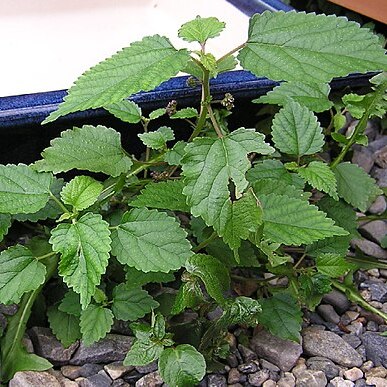Herbs, annual or perennial, without latex; monoecious. Stipules free, lateral, caducous. Leaves alternate, distichous; leaf blade margin toothed. Inflorescences axillary, usually bisexual, cymose, racemose, or spicate, shortly pedunculate, bracteate. Male flowers: calyx campanulate, 4-lobed, valvate; stamens inflexed in bud. Female flowers: sessile; calyx boat-shaped, 4-6-lobed, valvate; ovary free; style lateral; stigma 2-branched, filiform. Fruit free, not fleshy. Achenes small, oblique globose, ± compressed, enclosed by an enlarged calyx. Seed with a membranous coat; endosperm absent; cotyledon wide; embryo incurved.
Monoecious annual herbs without latex. Leaves alternate, simple, petiolate; stipules intra-petiolar, small. Inflorescence a bisexual capitate cyme. Perianth parts free or slightly connate, lightly villous. Male flowers: tepals 4, stamens 4; filaments inflexed in bud; pistillode present. Female flowers: tepals 4–6; ovary obovoid, often stipitate; style lateral, with a minute branch near base; stigma filiform. Fruit an achene, warted, asymmetrically globular to ovoid, slightly compressed, enclosed by persistent perianth; embryo curved with cotyledons equal.
Herbs , annual, caulescent, taprooted; sap not milky. Leaves alternate; stipules caducous, free. Leaf blade broadly ovate, margins toothed; venation nearly palmate. Inflorescences axillary, capitate cymes, short-pedunculate, bracteate. Flowers: staminate and pistillate on same plants. Staminate flowers: calyx 4-lobed; stamens 4, inflexed. Pistillate flowers: calyx green, 4-lobed, pubescent; ovary superior, oblique, 1-locular; style unbranched, nearly lateral. Syncarps globose; each achene surrounded by its enlarged, persistent calyx.

